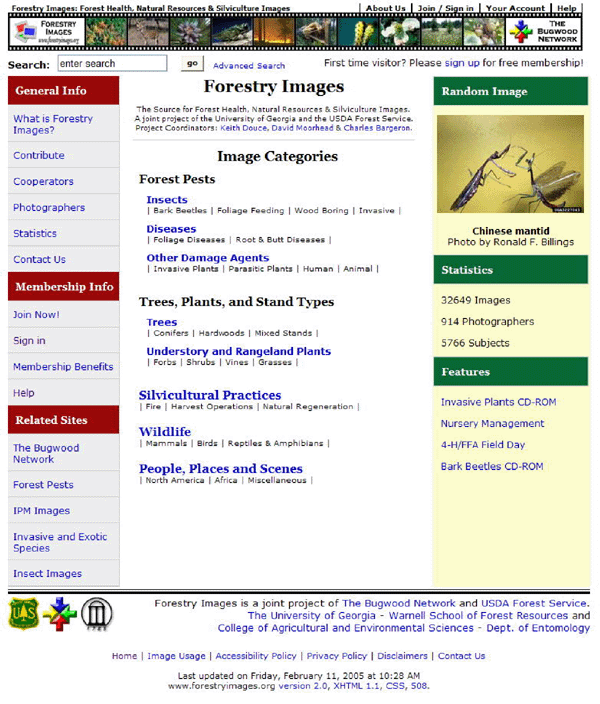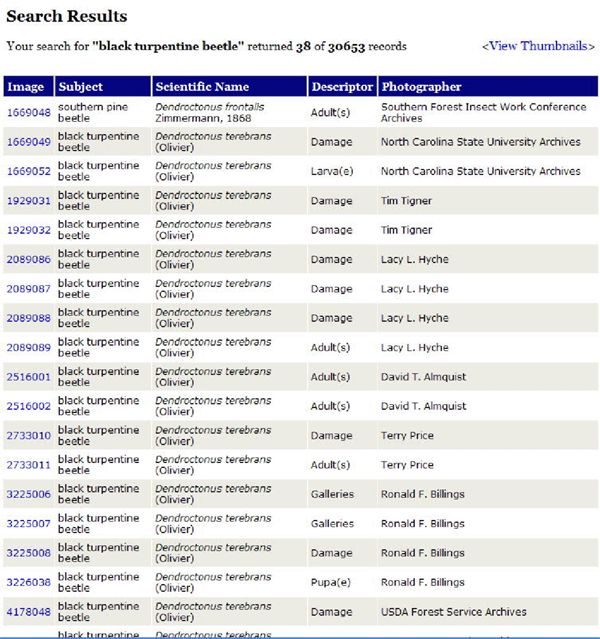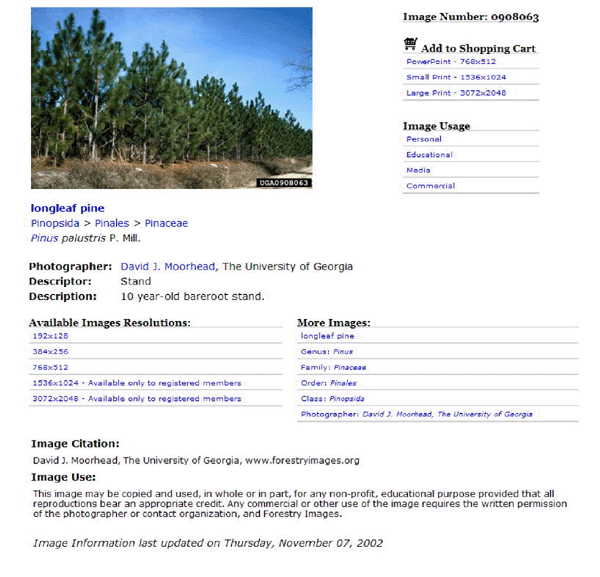April 2007 // Volume 45 // Number 2 // Tools of the Trade // 2TOT7
Forest Resources Digital Information System
Abstract
Forestry Images, the digitized documented forest health image archive, was developed with the aim to gather, create, maintain, and distribute digital information as tools to enhance and complement information exchange and educational activities. The Forestry Images System exists under the umbrella of Bugwood Network (Bargeron, Douce, & Moorhead, 2000). The increased volume of images and its usage statistics required major changes to enhance the system access, better content management, and security. The enhanced system is standard compliant based on recommendations from the World Wide Web Consortium (W3C) and the U.S. government Section 508.
Introduction
Forest health management decisions must be based upon correct identification of insects and diseases, and an understanding of the complex biology of the ecosystem in which they operate. Because forest insects and pathogens are small and varied, the availability of good images aids greatly in identification, and modern technologies allow, in addition to printed materials, visual presentations incorporating sound, text, images, and video. However, ready access to quality pictures of these organisms is often limited by the following:
- Location of relevant, high quality images,
- Access to the images when needed,
- Availability of these digitized images in suitable forms and formats for the desired applications,
- Availability of the biological and descriptive information needed, and
- Ability to use the images in several applications.
Forestry Images was developed to provide these resources to users.
Forestry Images is widely used by scientists, photographers, and Web users from around the world for research and educational purposes. Photographers make a significant contribution of images on a continuing basis, and Forestry Images has grown from 3,500 images to over 40,000 images. The statistical analysis of the survey data as well as system generated Web statistics indicate that the system has been extensively used on different platforms.
Features of the System
Forestry Images is a standards compliant (Zeldman, 2003), modular, fully documented system with improved performance and security. The system is further enhanced with the ability to sort tables and deliver images through a shopping cart feature. The system consists of the following components:
- Hardware: Intel Pentium Xeon based system
- Software: Microsoft SQL Server 2000 running on Windows 2000 Server
- Procedures: Stored procedures stored in SQL Server and ad hoc queries written in Adobe ColdFusion
- Data: Information centered around Images, Subjects and Photographers
Data in the Forestry Images System consist of images, subject description, and photographer. A subject table includes the taxonomic information, categories, common names, references, and other related information for classification and search functions.
Web Interface
The Web site is available at <http://www.forestryimages.org>. The site opens with the following home page (Figure 1).
Figure 1.
Forestry Images Homepage

Cascading style sheets are used for the site navigation bar (Home, About Us, Join/Sign in, Your Account, and Help) at the top right of each page (Figure 2), the topic-based area at center, and the left side bar to create a rollover effect and highlight the links.
Figure 2.
Forestry Images Header

The homepage allows users with different interests to locate images in two ways - searching and browsing.
Searching the Web Site
Searches can be performed using a number of criteria:
- Common name
- Scientific name
- Taxonomic hierarchy
- Host
- Photographer
- Designated image number
- Descriptor and descriptions
Search results display thumbnails (Figure 3) and associated information (Figure 4).
Figure 3.
Search Results (Thumbnails)

Figure 4.
Search Results (Description)

Browsing the Web Site
The browsing function is based on a series of selections from the website's classification system. The user first selects an area of interest on the homepage, then chooses from a list of categories or areas within that choice to receive a table of all subjects found in that classification displaying the subject name, scientific name, taxonomic order, and family. This takes the user to a subject page allowing the user to view the images, their descriptions, photographers, and full scientific taxonomy. Each taxonomic level is hyperlinked to a list of their children. The user may also choose to switch to a thumbnail view that provides options to increase the number of images shown on each page and to browse between pages.
The "final" page (Figure 5) of the browse interface is the detail page, and it includes all information relating to an image with a statement on how the image can be used and the proper image citation. Links to additional images of the subject and photographer are provided.
Figure 5.
Image Detail Page

Conclusion
Forestry Images System is a digital tool that provides readily accessible information and high-quality images to researchers, educators, and students. The system grows at an exponential rate as new images are added, and its access by users from around the world has also increased. The system is periodically evaluated to measure its performance and usefulness, and to adapt new technology as it becomes available to meet the needs of its users.
References
Bargeron, C. T, Douce G. K., & Moorhead D. J. (2000). Bugwood--The Web site and the concept. Invited Presentation at the 2000 National Extension Technology Conference, College Station, Texas, May 21-24, 2000.
Zeldman, J. (2003). Designing with Web standards. New Riders Publishing, Indianapolis, USA. 436 p.
